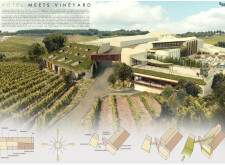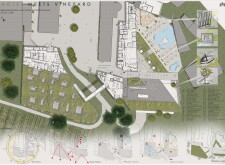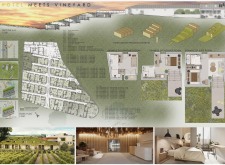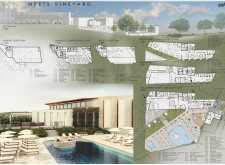5 key facts about this project
At its core, the project is intended to [insert function], serving as a space where [describe users and purposes, e.g., community gatherings, educational needs, etc.]. This functional clarity informs the architectural layout, allowing for fluid movement and interaction among users. The distribution of spaces within the project is intuitive, promoting functionality while ensuring comfort. The careful planning of layouts enables natural flow, facilitating the various activities intended to take place within the building.
The overarching design philosophy emphasizes sustainability without sacrificing style, employing a range of materials that are both environmentally friendly and contextually relevant. Key materials include concrete, which provides structural integrity, along with steel elements that reinforce the modern aesthetic. The extensive use of glass invites natural light deep into the building, creating a sense of openness and enhancing the user experience. This transparency blurs the boundaries between interior and exterior, allowing the surrounding landscape to become an integral aspect of the architectural narrative.
Unique design approaches are evident throughout the project, with spaces that adapt to the needs of their users. For instance, [describe specific architectural features such as multi-functional areas, movable walls, or outdoor-indoor transitions]. Such innovations not only foster versatility but also encourage community engagement by providing areas for both collaboration and solitude. The design includes thoughtfully integrated landscaping, employing local flora that complements the architecture while reinforcing environmental stewardship.
The roof design exemplifies ingenuity, potentially featuring elements such as green roofs or solar panels that contribute to energy efficiency. This aspect of the project reflects a commitment to reducing its ecological footprint and enhancing the local ecosystem. Furthermore, the architecture pays homage to local building traditions, with modern reinterpretations that reflect cultural heritage while embracing contemporary techniques.
Throughout the building, attention to detail is paramount. Finishes and fixtures are chosen not only for their aesthetic qualities but also for their durability and maintenance requirements, ensuring longevity in an everyday context. This commitment to quality can be seen in the choice of materials for surfaces, furnishings, and fittings, where tactile experiences are prioritized alongside visual appeal.
The architectural design embodies a rich dialogue between form and function, where each element serves a clear purpose while contributing to the overall cohesion of the structure. Innovative strategies are employed to address common architectural challenges, such as maximizing energy efficiency and enhancing user comfort through smart design solutions.
This project stands as a compelling example of how modern architecture can effectively blend functional demands with a strong sense of place. Its design strategies and material choices work in concert to create an inviting environment that is responsive to the needs of its users and the challenges posed by its surroundings.
For those interested in delving deeper into the architectural concepts and innovations that define this project, exploring the architectural plans, sections, and designs will provide valuable insights. Engaging with these elements can enhance understanding of the intricate details and thoughtful strategies that contribute to this architectural achievement, revealing the layers of intention behind every aspect of the design.


























